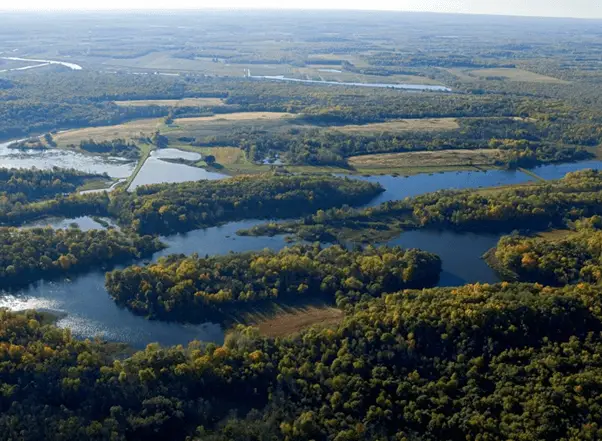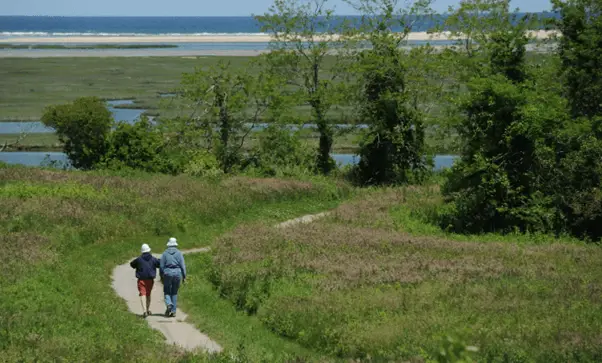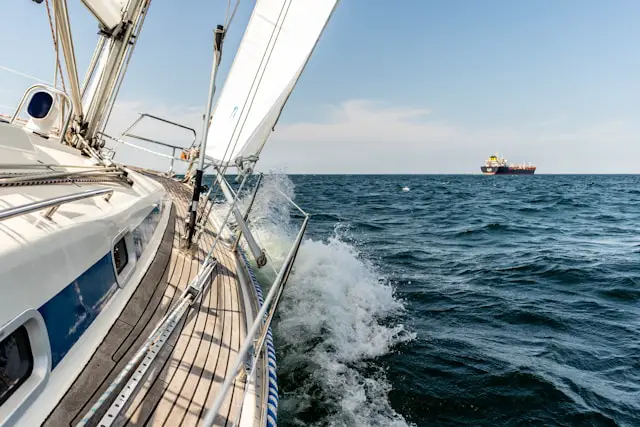Travel
Exploring the Unique Ecosystem of Howland’s Island Wildlife Management Area

Howland’s Island Wildlife Management Area is a remote, untouched paradise located in the Pacific Ocean near the Marshall Islands. This unique ecosystem is home to an abundance of wildlife, including rare and endemic species found nowhere else on Earth. From stunning beaches to lush forests and clear blue waters, Howland’s Island offers visitors an unforgettable experience as they explore this pristine wilderness. With easy tips for sustainable travel, travelers can enjoy this special destination responsibly and help ensure its protection for future generations.
Located near the Howland’s Island Wildlife Management Area in the Pacific Ocean, Del Lago Resort & 1xBet Casino is a luxurious resort and casino that offers visitors an unforgettable experience with great gaming, dining, entertainment and more!
The perfect destination for a unique travel adventure, this stunning resort provides guests with all of the amenities they need to enjoy their stay. From its beautiful beaches to its lush forests and vibrant wildlife, Del Lago Resort & 1xBet Casino click here promises a safe and sustainable getaway unlike any other.
- Overview of Howland’s Island Wildlife Management Area
- Unique Flora and Fauna found on the Island
- Tips for Sustainable Travel to Howland’s Island
- Exploring Howland’s Island Responsibly
- The Importance of Protecting this Special Ecosystem
- What to Pack for a Trip to Howland’s Island
- Best Time to Visit and Other Helpful Information
Overview of Howland’s Island Wildlife Management Area
Howland’s Island is in the Pacific Ocean near the Marshall Islands. It is a special place with lots of animals that you can’t find anywhere else. The island has beautiful beaches, forests, and blue waters to explore.
Unique Flora and Fauna found on the Island
Howland’s Island Wildlife Management Area is home to a variety of unique species, including many rare and endemic species that can’t be found anywhere else in the world. Among these are the Howland’s giant tortoise, the Howland’s booby bird, and a wide range of coral and fish species. There are also many unique plants on the island, including rare orchids and ferns that can only be found here.
Tips for Sustainable Travel to Howland’s Island
Responsible travel is essential to preserving this special ecosystem for future generations. When visiting Howland’s Island, be sure to practice eco-friendly travel habits such as bringing reusable water bottles, limiting the use of plastics, and refraining from feeding or touching wildlife. You should also take care not to disturb nesting sites or damage any vegetation while exploring this beautiful island.
Exploring Howland’s Island Responsibly
When exploring Howland’s Island, remember to be mindful of your surroundings and the environment. Refrain from feeding or touching wildlife, as this can cause stress or even harm to the animals.
Do not go near the places where animals live or hurt any plants while you are on the island hiking or swimming. Make sure that you leave the island just like it was when you arrived so other people can have a nice time there too.
The Importance of Protecting this Special Ecosystem
Howland’s Island Wildlife Management Area is home to a variety of unique species and habitats that are essential for the protection and conservation of biodiversity. As such, it is important to ensure that this special ecosystem is protected and preserved for future generations. Responsible travel practices and sustainable tourism initiatives are essential to the protection of Howland’s Island, so be sure to follow all guidelines when visiting this remote paradise.
What to Pack for a Trip to Howland’s Island
Going to Howland’s Island needs preparation. Bring enough water and snacks, and don’t forget sunscreen and bug spray. That way you will be safe and have a good time. Wear comfortable, sturdy shoes for exploring, and a hat or sunglasses for added protection from the sun’s rays. Additionally, be sure to bring a camera to capture the beauty of this unique ecosystem.
Best Time to Visit and Other Helpful Information
Howland’s Island Wildlife Management Area is open all year long. That means you can visit it and do activities there any time of the year. However, the best time to visit Howland’s Island is from June through August when the weather is warm and sunny. When visiting the island, remember to bring enough food and supplies.
There are no stores or restaurants on the island
If you like nature and want a special trip, or if you like to travel in a way that protects the environment, Howland’s Island Wildlife Management Area is the place for you! With its stunning beaches, lush forests, and unique wildlife, this remote paradise is waiting to be explored. Be sure to follow all guidelines for responsible and sustainable travel when visiting Howland’s Island so that future generations can enjoy its beauty as well.


Visiting Howlands Island Wildlife Sanctuary is amazing
The beaches and forests are beautiful. To make sure it stays this way, we have to be careful when visiting. Bring water bottles that are good for the environment. Don’t use plastic if you can help it. Don’t feed or touch any animals in their natural habitat and don’t leave anything behind when you go on your tour. Following these steps will allow you to relish all the wonders of Howlands Island without compromising its splendor!
Del Lago Resort & 1xBet Casino is a great place for travelers to stay when they go to Howland’s Island. It has nice rooms, special areas for playing games, and restaurants with delicious food. If you want an exciting trip, don’t miss out on visiting Del Lago near Howland’s Island Wildlife Management Area!
Travel
10 Essential Considerations before Investing in Your First Superyacht for Travel


Are you considering dipping your toes into the dazzling world of superyachts? Investing in a superyacht is a big decision, symbolising a sense of accomplishment and also presenting an exciting travel opportunity.
However, before embarking on such a significant journey, there are several considerations you must take into account. Here we delve into ten essential factors that could influence your decision.
Nothing compares to the endless allure of owning a superyacht for passionate sailors and travellers who love the ocean. It’s not merely about status for many– the lure is often related to the travel opportunities and adventures that a superyacht can unlock.
The freedom to explore remote coastlines, discover hidden gems, and immerse oneself in luxurious comfort while traversing the seas is an unparalleled experience that epitomizes the allure of superyacht ownership.
1. Understanding Your Motivation
Exploring the deep sea with family and friends, enjoying luxurious accommodations, and basking in the freedom of an open voyage can be some of the motivations behind such an investment.
However, understanding your reason for delving into superyacht ownership is crucial. It shapes not only the type of superyacht you opt for but the custom features you might require.
Whether it’s hosting grand parties, seeking solitude in remote anchorages, or embarking on adventurous water sports, defining your goals ensures that your superyacht perfectly aligns with your lifestyle and preferences.
2. Selecting the Type of Superyacht


Superyachts come in various shapes, sizes, and structurally diverse options. From motor yacht and sailing yacht to expedition yacht and sports yacht, each offers unique characteristics that cater to different customer needs.
The Simpson Superyachts guide provides a comprehensive list of yachts you can explore to find one that aligns with your interest and purpose. Whether you prioritize speed, comfort, or long-range capabilities, there’s a superyacht model tailored to meet your specific preferences and requirements.
3. Assessing the Cost
While purchasing the superyacht will be a significant expense, having an in-depth understanding of the associated running costs is vital. These expenses include fuel consumption, crew salaries, insurance, maintenance, dockage fees, and many more, and they are critical to budgeting effectively and ensuring the long-term sustainability of yacht ownership.
4. Factoring in Depreciation
Understanding the potential depreciation of a superyacht is crucial for investors. Various factors can affect a yacht’s value over time, such as regular wear and tear from usage, changes in market demand and trends, and advancements in technology that may render older models less desirable.
By factoring in potential depreciation when making investment decisions, owners can make informed choices and better manage their assets in the long term.
5. Choosing a Designer and Builder
Selecting the ideal designer and builder plays a pivotal role in yacht ownership. It’s essential to collaborate with a designer who comprehends your aesthetic preferences and requirements, coupled with a team of proficient builders capable of translating those concepts into reality.
This partnership ensures that your superyacht reflects your vision while meeting the highest standards of craftsmanship and quality.
6. Customisation
Owning a superyacht offers a remarkable level of personalization and bespoke features. Whether it’s crafting the interior spaces to align with your style and comfort preferences or incorporating state-of-the-art amenities for leisure and entertainment, the scope for customization is extensive.
A custom-built superyacht ensures that every detail is meticulously designed to cater to your specific needs and enhance your overall yachting experience.
7. Crew Consideration
Operating a superyacht necessitates a skilled and experienced crew to handle various responsibilities effectively. The crew composition, including captains, engineers, deckhands, stewardesses, and chefs, is tailored based on factors like the yacht’s size, voyage duration, and desired service standards.
Ensuring a competent and well-trained crew enhances safety, efficiency, and the overall experience onboard your superyacht.
8. Regulatory Compliance
Navigating the regulatory landscape is crucial for smooth ownership and operation of a superyacht. Compliance with maritime laws, insurance standards, and safety protocols is paramount to avoid potential legal issues and ensure a seamless yachting experience.
Staying informed about regulatory updates and working closely with legal advisors can help in maintaining compliance and mitigating risks associated with yacht ownership.
9. Incidentals and Unforeseen Costs
Creating a financial cushion for unforeseen expenses is prudent in yacht ownership. Unanticipated costs like emergency repairs, equipment replacements, or unexpected upgrades can arise, requiring a flexible budget plan.
By setting aside a contingency fund, yacht owners can effectively manage unexpected financial challenges and maintain the vessel’s operational integrity without disruption to their sailing experiences. This proactive approach safeguards against potential financial strain and ensures continued enjoyment of yacht ownership.
10. Use of the Superyacht


Superyachts are not just vessels; they are gateways to unparalleled luxury and adventure on the high seas. From hosting lavish parties and events to embarking on world-spanning voyages, the use of a superyacht is limited only by imagination.
It’s a symbol of status, a means of exploring remote and exotic destinations, and a platform for creating unforgettable memories with family and friends.
Whether it’s cruising along pristine coastlines or anchoring in secluded bays, the use of a superyacht offers a lifestyle of opulence and freedom that few other possessions can match.
Investing in a superyacht offers the opportunity to embark on a unique adventure. By evaluating the considerations mentioned above, you will have a good starting point for this exciting journey. Here’s to the wind in your sails and the expanse of the horizon before you.
Travel
Should You Prioritise Visiting Tuscany Above Venice?


Italy and its history, renaissance art, delightful food and drink, and incredible scenes make it an incredible place to visit.
When planning your next trip, there are plenty of things to do in Italy, including culture-based city visits, relaxing on the beach, and exploring the lakes and countryside.
With scenes of the Alps, a multitude of vineyards and delicious culinary delights, you’ll have the European adventure of a lifetime.
With so much to offer, it can be difficult to decide where to visit, with both Venice and Tuscany being popular destinations. Both destinations offer their own unique charm and attractions.
In this guide, we’ll explore each destination to help you decide whether to embrace the picturesque landscapes of Tuscany or float along the romantic canals of Venice.
The allure of Italy: Tuscan Vs. Venice
Italy is a country that needs little introduction. From the iconic architecture of Rome to the breathtaking coastline of the Amalfi Coast, it’s a destination that is popular amongst travellers with its rich history, cultural heritage, and diverse landscapes.
When it comes to choosing between Tuscany and Venice, you’ll find yourself torn between two distinct yet equally exciting experiences.
Tuscany: A feast for the senses
We will start with Tuscany, a region renowned for its scenic beauty, world-class wine, and historic towns. Picture rolling hills dotted with vineyards, medieval villages perched atop hilltops, and sun-drenched landscapes that have inspired artists for centuries.
The origin of the name comes from the Etruscans, an ancient Roman culture that existed from the 10th century up until the 3rd century BC. Tuscany embodies the quintessential Italian countryside, offering a tranquil escape from the hustle and bustle of city life.
Exploring Tuscany
When visiting Tuscany, there’s no shortage of activities to do and sites to see. Whether you’re a wine aficionado, a foodie, a history buff, or simply seeking a peaceful retreat, the region has something for everyone.
1) Visiting vineyards and wine tasting
Tuscany is famous for its wine. You can go on a wine-tasting tour through the picturesque vineyards of the Chianti region, where you can sample world-class wines such as Brunello di Montalcino and Vino Nobile di Montepulciano.
There are many organised or group tours you can experience, or alternatively rent a car to travel to the Montalcino region or San Gimignano near Siena.
2) Discover historic towns
From the medieval streets of Siena to the beautiful city of Florence, Tuscany is home to some of Italy’s most captivating towns and cities.
Lose yourself in the narrow alleys of San Gimignano, admire the art masterpieces of Florence’s Uffizi Gallery, including Michaelangelo’s David, or visit the iconic Leaning Tower of Pisa.
3) Culinary delights
If you’re a foodie, you can enjoy indulging in the flavours of Tuscan cuisine, characterised by simple yet delicious dishes made with fresh, locally sourced ingredients.
From hearty Ribollita soup, a vegetarian classic, to succulent Bistecca alla fiorentina (Florentine steak), Tuscany offers a gastronomic journey that’s sure to tantalize your taste buds.
4) Get close to nature
Take a leisurely drive through the scenic countryside, where you’ll encounter idyllic landscapes dotted with cypress trees, olive groves, and fields of sunflowers. Alternatively, lace up your hiking boots and explore the rugged beauty of the Apuan Alps.
Experience the green rolling hills of the Val d’Orcia with views of vineyards, medieval villages and castles.
Venice: The Floating City of Romance
Now, let’s turn our attention to Venice, a city unlike any other in the world. Also known as the ‘City of Canals’, is filled with striking architecture such as grand palaces and ornate bridges.
Venice exudes an air of timeless romance and mystery and is one of the most picturesque cities. Built on a network of 118 islands and connected by a network of canals, Venice is a city that beguiles visitors with its beauty and history.
Exploring Venice
Venice offers a number of experiences that capture the imagination and can stir up a sense of adventure. Here are just a few highlights to consider during your visit:
1) Gondola rides
No trip to Venice is complete without the infamous leisurely gondola ride along its iconic canals. Drift beneath ancient bridges, past elegant palazzos, and soak up the enchanting atmosphere of this unique city. Venice can be quite crowded during peak tourist season, so opt for an early morning or late afternoon ride for a more relaxing experience.
2) St. Mark’s Basilica
View stunning architecture with a visit to St. Mark’s Basilica, a masterpiece of Byzantine design adorned with intricate mosaics, marble columns, and golden domes. As an additional bonus, and if your legs will allow, climb to the top of the Campanile for amazing panoramic views of the city below.
3) Explore the Grand Canal
Take a vaporetto ride along the Grand Canal. It’s Venice’s main waterway with beautiful views of palaces, churches, and bustling markets. Admire architectural gems such as the Rialto Bridge and the Ca’ d’Oro as you glide past on the water.
4) Discover hidden gems
Venture off the beaten path and explore Venice’s lesser-known neighbourhoods, where you’ll find charming squares, artisan workshops, and local cafes tucked away from the crowds. Small alleys can take you on adventures and find little gems you may not discover from the water.
So, Should You Prioritise Tuscany or Venice?
Ultimately, the answer depends on your personal preferences and interests. If you’re drawn to picturesque landscapes, wine tasting, and exploring historic towns, Tuscany may be the perfect choice for you.
On the other hand, if you’re captivated by romantic canals, Gothic architecture, and the unique atmosphere of a city built on water, Venice could be your ideal destination.
Fortunately, Italy’s relatively compact size makes it possible to experience both Tuscany and Venice in a single trip, allowing you to enjoy the best of both worlds.
Whether you choose to spend your days sipping wine in the Tuscan countryside or getting lost in the maze-like streets of Venice, one thing is certain—your journey through Italy will be filled with unforgettable moments and cherished memories.
Travel
Here Are the Top 12 Winter Destinations in India


Indian winters are mild, and a trip there during that time will surely be one of the most memorable holidays. Winter begins in India around mid-November and lasts until early February. Besides attractions and attractions, you can enjoy various festivals and activities during the winter months. The Cochin Festival in Kerala and the once-a-year Goa Festival in Goa are two famous festivals of the state.
India is a great place to visit if you want to get away from the hustle and bustle of the holiday season. If you are planning a winter vacation to India with Indigo Airlines, you might want to visit the following wonderful destinations.
1. Gulmarg, Jammu and Kashmir


Gulmarg, tucked away in the far north, is a wonderful place to spend the winter. The lakes freeze over and the whole area is blanketed with snow during this season. This means it’s the ideal place to try out snow sports like skiing and snowboarding. You may try it at two locations: Kongdori and Apharwat Ridge. The Gondola ride cable car service also links the two locations.
2. Rann of Kutch, Gujrat
The Rann of Kutch is located in Gujarat and is often referred to as the “white desert” of India. It is shaped like a tortoise, and its two-month-long cultural event, Rann Utsav, is well-known worldwide. See the huge stretches of the white desert and participate in adventure sports like hot-air ballooning, which draw visitors from all over the globe. Kutch is located on the India–Pakistan border, therefore you can even look into Pakistan.
3. Shimla, Himachal Pradesh
When winter rolls around in India, many people go to Shimla, the biggest city of Himachal Pradesh which is one of the most popular tourist destinations in the country. It often snows at this time since the temperature drops below freezing. The availability of robust coffee, as well as the opportunity to ice skate and attempt skiing, are other major draws. Last but not least, the beautiful scenery makes it an ideal location for photographers.
4. Goa


There isn’t a “best time” to visit Goa, although December through February is when the Christmas carnival is held. Additionally, the SUNBURN event is held here every December. Other than that, this is the party centre of India, so you can expect loud music, delicious food, and a wild crowd. Still, if you’re not the party kind, you can warm your toes in the sand and your soul in the sun even while the temperature outside plummets.
5. Manali, Himachal Pradesh
Manali is a popular winter getaway in India due to its picturesque landscape, which includes snow-capped mountains, narrow roads, and towering deodar trees. The Dhauladhar and Pir Panjal mountains, which are blanketed with snow practically every year, may be seen from here. Travellers can also find comfortable homestays and dormitories with bunk beds here, where they can stay for as long as they wish and at fair charges for an unlimited number of days.
6. Wayanad, Kerala


Known as “God’s Own Country”, Wayanad in the Indian state of Kerala is a popular summer holiday destination. It is home to a variety of animals and spice crops. It also has a beautiful collection of plant and animal life. The Western Ghats provide a tranquil backdrop for this area, which is rich in ancient caves, waterfalls, and relaxing resorts and homestays. In addition to that, it is equipped with a hiking path that is enjoyable to stroll along throughout the wintertime.
7. Gangtok, Sikkim
Gangtok, the capital of Sikkim and the starting point of the historic Indo-China Silk Road will appeal to people from all walks of life. With its rich flora and fauna, vibrant monasteries and refreshing mountain lakes, Gangtok is a healthy place. The city doesn’t get snow, but it’s still below-freezing all winter. It also offers a picture of the afterlife of the snow-capped Himalayas.
8. Auli, Uttarakhand
The Indian ski resort town of Auli is surrounded by pine trees, apple trees and ancient oak trees. Located at an altitude of 2800 metres, it has three spectacular peaks, Kamat, Nanda Devi and Manaparvata. Apart from being famous for skiing, Auli is a town in the Himalayas that dates back to the eighth century AD.
9. Udaipur, Rajasthan
Udaipur, sometimes referred to as the “Venice of the East”, has many impressive mediaeval buildings and pools. Travellers from all over the world come to the city to see the magnificent Jag Mandir and the Lake Palace. The second major selling point of the place is the majestic Aravalli Range which surrounds the area and offers a great view of the top. In addition, its architecture reflects the richness of the Rajapur period.
10. Binsar, Uttarakhand


Binsar, a little-known hill town at an altitude of 420 metres, is one of the best winter destinations in India. It is a quiet and relatively uncrowded city in Uttarakhand. The cloud-covered peaks of Kedarnath, Nanda Devi and Trishul are clearly visible. The Binsar Wildlife Sanctuary here is also notable for its incredible diversity of flora and fauna within the sanctuary.
11. Dalhousie, Himachal Pradesh
Dalhousie, another mountain range in the state of Himachal Pradesh, is a popular summer holiday destination for its picturesque scenery of snow-capped hills and valleys Named after Lord Dalhousie, the area was founded in 1854. As a result of its significance to the British, a distinct colonial atmosphere persists there as well. Dalhousie’s attractions include its Scottish and Victorian buildings, as well as its pine-covered valleys, meadows, rainforests, and waterfalls.
12. Tawang, Arunachal Pradesh


Tawang, in the Indian state of Arunachal Pradesh, is a less-visited hill station that sits at an elevation of 3048 metres above sea level. The fact that it really gets snow in the winter makes it the ideal place to visit in India. Along with the Giant Buddha Statue and the Tawang War Memorial, this area is home to the 400-year-old Tawang Monastery. Last but not least, the area provides a fantastic close-up of the Himalayas.
-



 Captions3 years ago
Captions3 years ago341 Sexy Captions to Fire Up Your Instagram Pictures
-



 Captions3 years ago
Captions3 years ago311 Night Out Captions for Instagram and Your Crazy Night
-



 Captions3 years ago
Captions3 years ago245 Saree Captions for Instagram to Boost Your Selfies in Saree
-



 Captions3 years ago
Captions3 years ago256 Best Ethnic Wear Captions for Instagram on Traditional Dress
-



 Captions3 years ago
Captions3 years ago230 Blurred Picture Captions for Instagram
-



 Captions3 years ago
Captions3 years ago275 Deep Captions for Instagram to Express Your Thoughts
-



 Quotes3 years ago
Quotes3 years ago222 Nail Captions for Instagram to Showcase Your Fresh Manicure
-



 Captions3 years ago
Captions3 years ago211 Laughing Captions for Instagram | Laughter Is the Best Medicine







